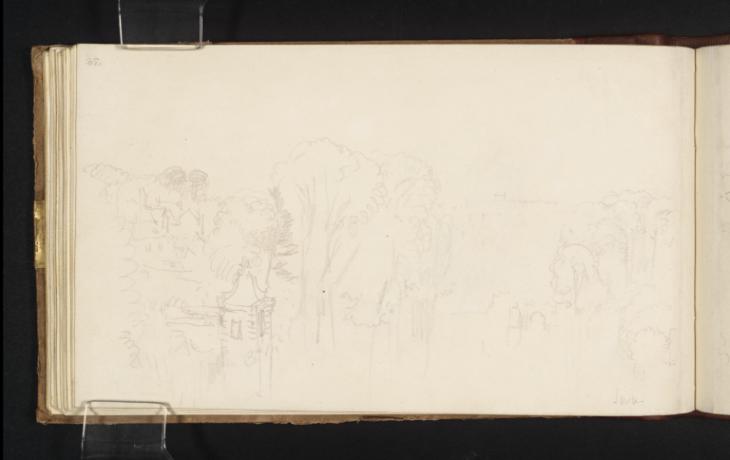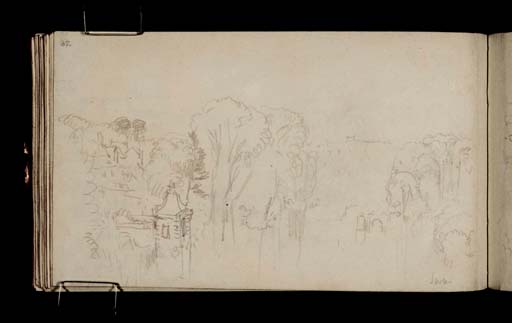J.M.W. Turner
>
1830-35 Annual tourist
>
Midlands 1830
>
Kenilworth Sketchbook
>
Artwork
Joseph Mallord William Turner Warwick Castle from the Avon Bridge 1830
Image 1 of 2
Joseph Mallord William Turner,
Warwick Castle from the Avon Bridge
1830
Joseph Mallord William Turner 1775–1851
Folio 38 Verso:
Warwick Castle from the Avon Bridge 1830
D22047
Turner Bequest CCXXXVIII 38a
Turner Bequest CCXXXVIII 38a
Pencil on white wove paper, 120 x 203 mm
Inscribed by Turner in pencil ‘B[...]’ bottom left and ‘Swan’ bottom right
Inscribed in pencil ‘38’ top left, upside down
Inscribed by Turner in pencil ‘B[...]’ bottom left and ‘Swan’ bottom right
Inscribed in pencil ‘38’ top left, upside down
Accepted by the nation as part of the Turner Bequest 1856
Exhibition history
1878
Oxford Loan Collection, University Galleries, Oxford 1878–1909 or later (190; renumbered 153[a], as ‘Warwick. For England Drawing’).
References
1904
E.T. Cook and Alexander Wedderburn eds., Library Edition: The Works of John Ruskin: Volume XIII: Turner: The Harbours of England; Catalogues and Notes, London 1904, p.566 (Oxford loans catalogue, 1878) no.153[a], as ‘Warwick. For England Drawing’.
1909
A.J. Finberg, A Complete Inventory of the Drawings of the Turner Bequest, London 1909, vol.II, p.730, CCXXXVIII 38a, as ‘View from bridge, Warwick Castle’.
1952
A.C. Sewter, Water Colours by J.M.W. Turner, R.A., exhibition catalogue, City of Manchester Art Gallery 1952, p.20 under no.58.
1966
Francis W. Hawcroft, Exhibition of Watercolours by J.M.W. Turner, exhibition catalogue, Whitworth Art Gallery, Manchester 1966, p.27 under no.37.
1979
Eric Shanes, Turner’s Picturesque Views in England and Wales 1825–1838, London 1979, p.156, as CCXXXVIII ‘30a’ (sic).
1984
Craig Hartley, Turner Watercolours in the Whitworth Art Gallery, exhibition catalogue, Whitworth Art Gallery, Manchester 1984, p.48 under no.38.
1997
Charles Nugent and Melva Croal, Turner Watercolors from Manchester, exhibition catalogue, Memphis Brooks Museum of Art, Memphis 1997, p.84 under no.51.
Warwick Castle overlooks the River Avon in the county town of Warwickshire. While its beginnings are traceable to the Norman Conquest and before, its most prominent features, Caesar’s Tower and Guy’s Tower, date from the fourteenth century. Long associated with the Earls of Warwick, it has been in commercial ownership since 1978.1 Here Turner looks west to the lightly indicated river frontage of the castle from the bridge over the Avon, and continues on folio 39 recto opposite (D22048) with more of the castle and the view north-west to the pinnacled tower of St Mary’s Church in the town beyond. The view is little changed today. The section of the castle on this page is studied in more detail on the recto (D22046).
As John Ruskin and others have recognised,2 the double-page composition, cropped a little at either side, together with the detail of the castle on the recto (D22046), informed the watercolour design of about 1830 (Whitworth Art Gallery, Manchester),3 engraved in 1832 as Warwick Castle, Warwickshire for Turner’s Picturesque Views in England and Wales (Tate impressions: T04594, T04595). The overall view from further east on folio 40 recto (D22050) may also have been consulted.
There are two pencil views of the castle from Turner’s 1794 visit (Tate D00327, D00328; Turner Bequest XXI A, B), and a watercolour study from the late 1790s (Tate D00329; Turner Bequest XXI C). A finished 1794 watercolour of Warwick Castle and Bridge is, like the England and Wales view, at the Whitworth Art Gallery;4 it shows the castle from a similar angle, but from water level, dramatically framed through the arch of the Avon bridge. A watercolour of inconspicuous buildings through trees beyond water, traditionally known as ‘Warwick Castle’ (Tate T01021), does not bear any close relationship to the topography of the site.
There are further views of Warwick on folios 39 verso and 40 recto (D22049, D22050) and on 58 verso (D22084; Turner Bequest CCXXXVIII 56a). For James Hamilton’s suggestion that an engraved ‘Little Liber’ subject (traditionally known as ‘Gloucester Cathedral’ and dated to the 1820s) actually represents St Mary’s Church, Warwick from Hill Wootton and postdates the 1830 tour, see the present author’s entry for its associated watercolour study (Tate D25430; Turner Bequest CCLXIII 307).
Matthew Imms
August 2013
‘History and Restoration’, Warwick Castle, accessed 24 June 2013, http://www.warwick-castle.com/explore-castle/history-and-restoration.aspx .
How to cite
Matthew Imms, ‘Warwick Castle from the Avon Bridge 1830 by Joseph Mallord William Turner’, catalogue entry, August 2013, in David Blayney Brown (ed.), J.M.W. Turner: Sketchbooks, Drawings and Watercolours, Tate Research Publication, September 2014, https://www


